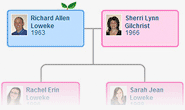 Follow Us
Follow Us Like Us
Like Us



John Anderson here treated is designed John Anderson of Stobcross in an account of the family that was published in the Genealogy Magazine of New Jersey. In this account he is identified as the son of John Anderson, notary public and clerk of the diocese of Glasgow, who was alive in 1539 and is said to have been born in 1515. John Anderson here treated is also said to have married Janet Andrew and to have had with her one son named Ninian Anderson of Dowhill and Stobcross, who is said to have bee born in 1555. Anderson Families in Scotland
It is difficult or impossible to determine how the author of the New Jersey account of the Anderson family arrived at the position outlined above but it would seem that he has confused the family who held the Dowhill estate with the family who held the Stobcross estate. It could be said of John Anderson here treated that he appears to be the near contemporary of John Anderson of Stobcross (who had his floruit 1595-1615) but the laird of Stobcross is clearly a different person for he is certainly known to be the son of William Anderson of Stobcross. Glasgow Protocols number 3348
Robert Reid (alias Senex), the Glasgow historian, was under the false impression that Stobcross was: "formerly the property of the Andersons of Dowhill" but he was mistaken. However, his error, if it was not entirely responsible for it, probably contributed greatly to the modern misconception, that ownership of the Stobcross and Dowhill estates was vested in the same family. It is entirely possible that the Andersons of Stobcross were related to the Anderson family who held the Dowhill estate but evidence which might prove this is presently wanting. Old Glasgow and its Environs
According to Charles MacIntosh: "In 1556 John Anderson was one of the Stentors of the merchants, employed to levy the Glasgow portion of the tax imposed that year upon the royal burghs of Scotland. In 1577, he was possessed, with other property, of a tan work, in the Dowhill, which, it is somewhat remarkable, continued to be occupied as such, in the possession of the family, till it was sold in 1754, by Dr. John Moore their remote descendant." Sketch of the Family of Anderson of Dowhill
Branches: Candacraig (Strathdon), Dowhill, Wester Ardbreck Motto: Stand Sure.
Gaelic Name: MacGhille Aindrais
There are two versions of the name Anderson (the Lowland form) and MacAndrew (the Highland version), both mean son of Andrew, the patron saint of Scotland. The MacAndrews were renowned for their fighting qualities and were part of the Confederation of Highland clans, the Clan Chattan. There is no chiefly line at present.
Our heritage comes from the Lowland Andersons, who achieved fame in different quarters. Alexander Anderson's early 17th century treaties on geometry and algebra gained European recognition. James Gregory, the inventor of the reflecting telescope, was an Anderson. In 1773, James Anderson from Midlothian, wrote the entry on monsoons for the first edition of the Encyclopaedia Britannica, predicting the discoveries to be made by Captain Cook. John Anderson (1726-1796), Professor of Natural Philosophy at Glasgow University, invented a way to reduce the recoil in a gun, and helped found one of Scotland's eight universities (Strathclyde University).
The Anderson Tartan is unique among all of the Scottish tartans. This is because it is the only tartan to have seven colors. All other tartans have six or less. Because of this, the Anderson tartan must be woven on a special loom. The colors are primarily a rich blue with yellow, green and red in the plaid. Three variations exist: The Ancient colors which are derived from the color scheme set mostly by natural old world style dyes, The Modern colors derived from the use of modern chemical dyes and the Muted colors which simulate a " weathered " tartan. The Royal Canadian Air Force tartan, which has only five colors, is an officially registered variant of the Clan Anderson tartan. From a distance it is difficult to distinguish between the two.